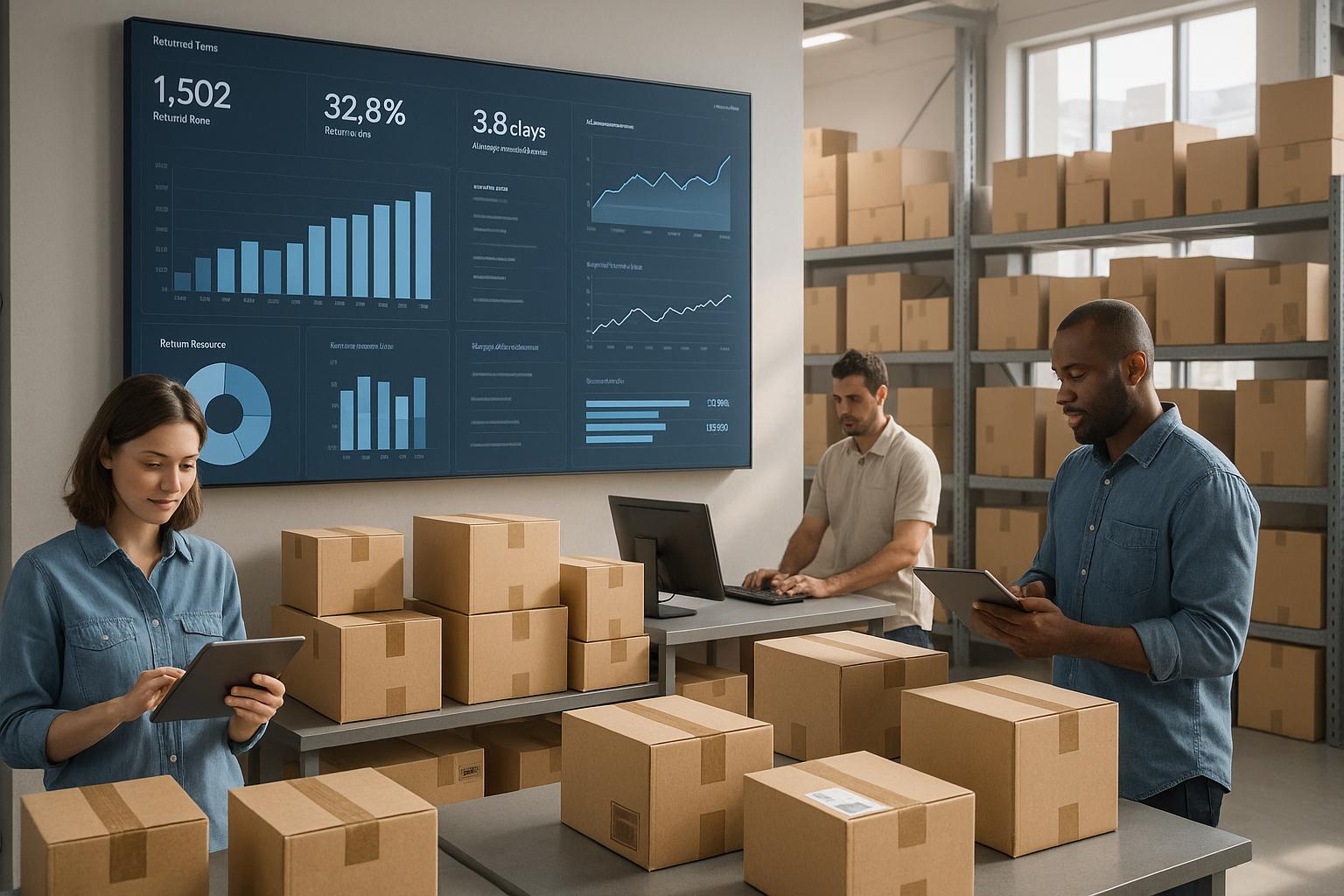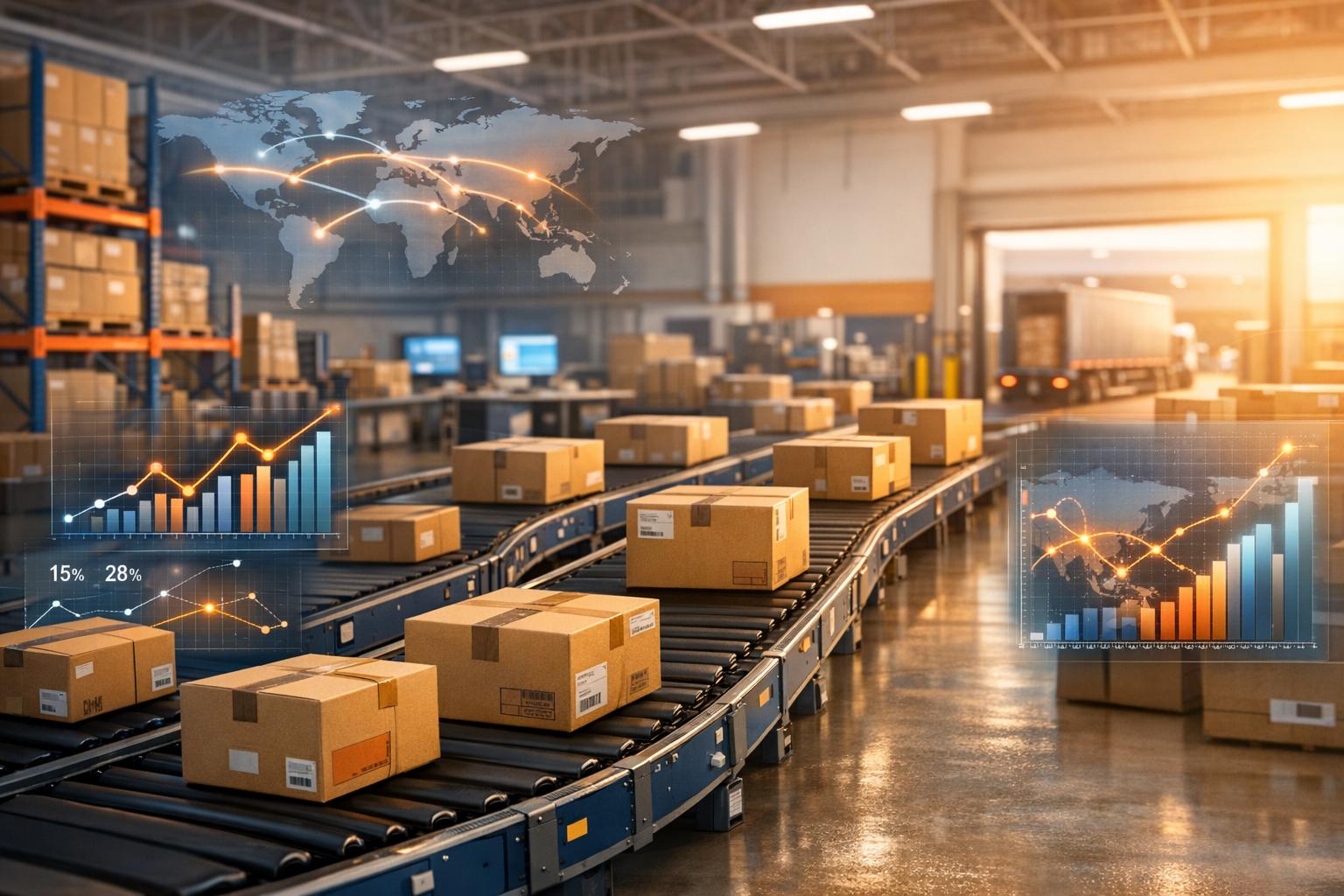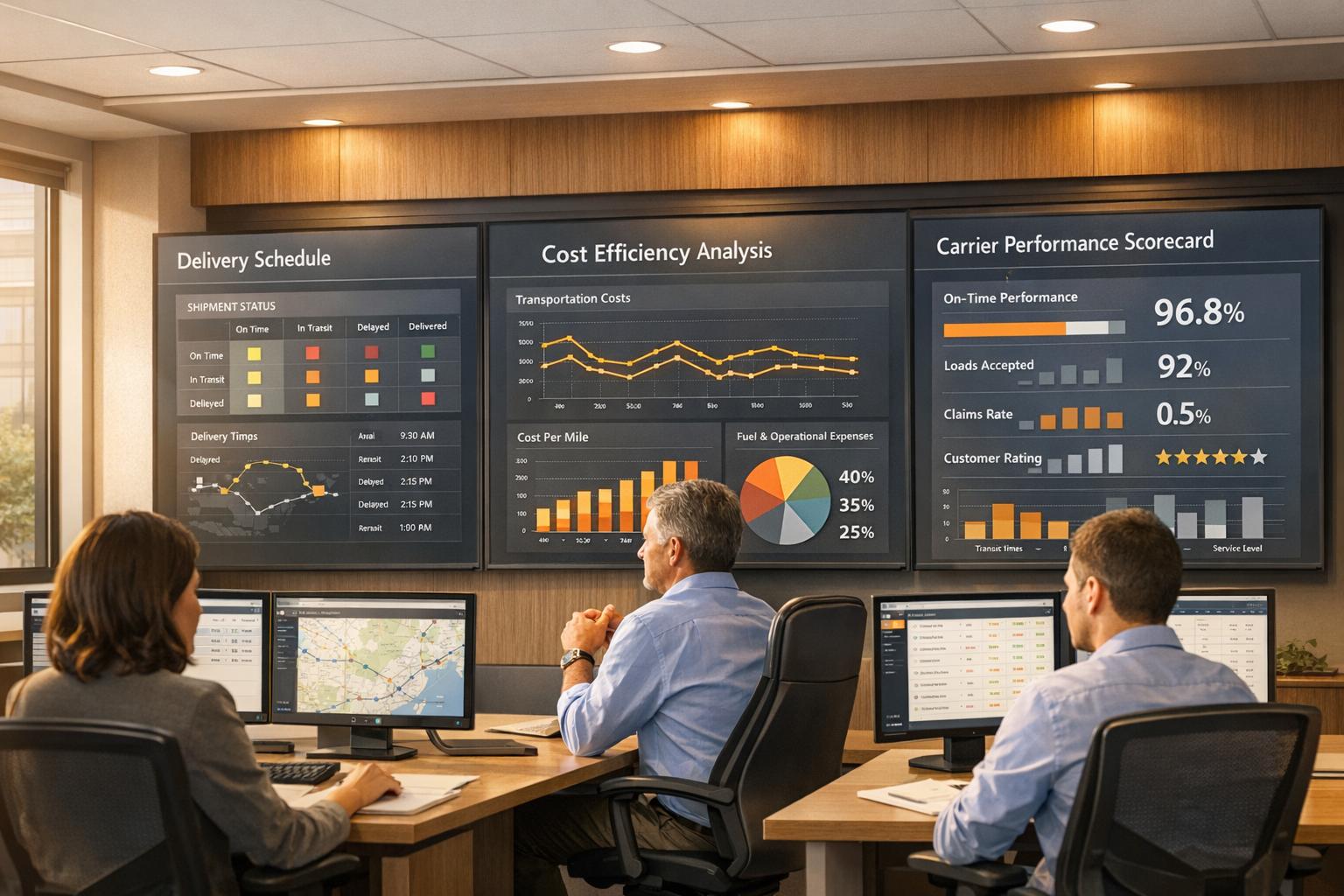How 3PLs Use Data for Reverse Logistics Success

E-commerce thrives, but high return rates - 30% online vs. 10% in-store - pose challenges. Reverse logistics, the process of managing product returns, is costly and impacts profits. Third-party logistics (3PLs) are transforming this with data analytics, addressing key issues like slow manual processing, lack of real-time tracking, and international return complexities.
Key insights:
- Data's role: Analytics predict return trends, optimize operations, and improve customer satisfaction.
- Automation: Smart routing reduces errors and speeds up processing.
- Sustainability: Data identifies recycling opportunities and minimizes waste.
- KPIs to track: Return processing time, costs, and resale percentages.
What Are Best Practices For Reverse Logistics In Supply Chains? - Smart Logistics Network
Main Reverse Logistics Problems for E-commerce Brands
Managing returns presents some tough challenges for e-commerce brands, often putting a strain on operations and impacting efficiency. By breaking down these issues, it becomes clear why many businesses struggle to streamline their reverse logistics processes. These hurdles also highlight opportunities where data-driven solutions can make a real difference.
Manual Processing Slows Everything Down
Relying on manual processes to handle returns is a major roadblock. When employees are tasked with inspecting and processing returns by hand, things naturally slow down. Not only does this increase the likelihood of errors, but it also drives up labor costs and delays getting inventory back into circulation. These bottlenecks can lead to postponed product availability, longer wait times for customer refunds, and ultimately, cash flow problems. Plus, slow refunds and delays can seriously impact customer satisfaction, making it harder to retain loyal shoppers.
Lack of Real-Time Return Tracking
Not having clear visibility into return statuses creates chaos in reverse logistics. Without real-time updates, businesses are forced to make decisions based on outdated or incomplete information. This can throw off inventory management and disrupt operational planning. Customers also feel the pinch - when they can’t track their returns or get a clear timeline for refunds, frustration builds. A smooth return process matters: 92% of shoppers are more likely to buy again from brands that make returns easy and transparent. Disconnected systems and poor communication only add to the confusion, creating silos that slow everything down.
Managing International Returns Is a Headache
Handling cross-border returns is a whole different level of complexity. Businesses have to navigate customs forms, duty calculations, and varying regulations, all of which can cause delays and drive up costs. For instance, returned items coming from overseas often need the same customs clearance as new imports, requiring precise documentation to avoid holdups. On top of that, dealing with multiple currencies and fluctuating exchange rates can make refunding customers a logistical nightmare. Shipping costs for international returns can also be disproportionately high compared to the product’s value, forcing companies to rethink whether accepting these returns is even worth it. These challenges underline the need for integrated, data-driven approaches to manage reverse logistics efficiently.
How 3PLs Use Data Analytics to Improve Reverse Logistics
Third-party logistics providers (3PLs) are reshaping reverse logistics by using data analytics to anticipate challenges, fine-tune operations, and turn returns into opportunities rather than just expenses.
Real-Time Tracking: A Clearer View of Returns
With real-time tracking systems, 3PLs can follow every step of a return's journey, eliminating the uncertainty of traditional methods. These systems capture data at every stage - from the moment a return is initiated to when it re-enters inventory. This transparency benefits both businesses and their customers, offering a clear view of where returns are in the process.
For example, many 3PLs use advanced, proprietary systems that combine analytics with tracking to predict returns and allocate resources more effectively. These tools can identify products with a higher likelihood of being returned, analyze customer behavior, and optimize return routes to ensure smoother handling.
This level of visibility not only streamlines operations but also keeps customers informed, improving their overall experience. Additionally, real-time tracking helps 3PLs quickly identify and address bottlenecks, such as delays in specific facilities or processing steps. By doing so, they can adjust workflows and resources promptly, paving the way for predictive tools that refine return forecasting.
Predictive Analytics: Anticipating Returns with Precision
Predictive analytics is a game-changer for reverse logistics, allowing 3PLs to forecast return patterns with impressive accuracy. By analyzing historical trends, carrier data, seasonal fluctuations, and even anomalies, AI-driven models predict return volumes up to eight weeks in advance. This insight helps retailers better manage staffing, avoid extra fees, and speed up refunds and restocking processes.
These models boast an 85% accuracy rate in forecasting return volumes, leading to a 30% improvement in warehouse efficiency. Retailers using this approach report a 25% reduction in operational costs thanks to smarter resource allocation.
"Predictive analytics transforms reverse logistics from a reactive process into a proactive, value-generating operation aligned with sustainability."
By processing multiple data streams simultaneously, predictive tools uncover seasonal trends, product-specific return issues, and customer behavior patterns. This allows 3PLs to allocate resources more effectively and even anticipate the condition of returned items. For instance, systems can predict whether a product will need refurbishment or testing, enabling managers to prepare the right staff and equipment. These tools can identify unusual return patterns with 80% precision, helping businesses address potential disruptions before they escalate.
System Integration: Connecting the Dots
Seamless system integration is the backbone of data-driven reverse logistics. Modern 3PLs combine enterprise resource planning (ERP) systems, inventory management tools, and customer service platforms into a single, unified ecosystem. This integration ensures that data moves freely across departments, eliminating silos and reducing delays. For instance, when a return is initiated, it can immediately update inventory levels, notify warehouses, and adjust financial projections - all without manual intervention.
JIT Transportation is a great example of this approach. Their system integrates transportation, distribution, and returns management into one platform, ensuring smooth data flow across all touchpoints in the reverse logistics process.
Integration also enables deeper analytics. By combining data from multiple sources in real time, 3PLs can uncover insights such as how shipping methods affect return rates, which regions see higher product returns, and how to optimize routes for both forward and reverse logistics.
-
Regression Analysis
- Application: Predicting return volumes based on sales and seasonality
- Benefits: Better resource planning and cost forecasting
-
Time Series Analysis
- Application: Forecasting future return volumes
- Benefits: Improved inventory and staffing decisions
-
Machine Learning Classification
- Application: Categorizing returned products by condition
- Benefits: Faster processing and turnaround times
-
Optimization Algorithms
- Application: Streamlining return routes and resource allocation
- Benefits: Lower transportation costs and higher efficiency
These integrated systems deliver tangible benefits. Faster return processing and better resource management can boost customer satisfaction by 20%. A smoother returns process encourages repeat business and positive recommendations.
"By enabling more accurate planning and resource allocation, predictive analytics can help reduce operational costs in reverse logistics."
When combined, real-time tracking, predictive analytics, and seamless integration give 3PLs the tools to turn returns into a strategic advantage. This approach not only enhances customer satisfaction but also reduces costs and minimizes waste, making reverse logistics a win-win for businesses and their customers alike.
Data-Driven Methods for Better Reverse Logistics
Modern reverse logistics is becoming smarter and more efficient thanks to data-driven analytics and integrated systems. Today’s leading third-party logistics providers (3PLs) are leveraging data not just for tracking but for creating intelligent systems that enhance every step of the returns process. By improving operations, cutting costs, and aligning with sustainability efforts, these methods are reshaping how businesses manage returns. Let’s dive into how automation, environmental insights, and ongoing KPI monitoring are refining reverse logistics.
Automation and Smart Routing: Cutting Out the Hassle
Automation is a game-changer for reverse logistics, removing repetitive tasks and reducing human error. Smart routing algorithms take into account factors like product type, condition, destination, and carrier capacity to identify the most efficient path for returns. This ensures that pickups and processing are consolidated and streamlined.
Take JIT Transportation, for example. They’ve built a system that uses advanced technology and a flexible network to adapt to fluctuating demand. Their automated workflows allow for seamless data sharing across departments, enabling them to process returns in under 24 hours - a benchmark that sets a high standard for the industry.
Data Insights: A Boost for Environmental Goals
Data analytics isn’t just about improving efficiency; it also plays a big role in reducing environmental impact. Optimized route planning cuts down on travel distances, which in turn lowers fuel consumption and emissions. Beyond that, data can help identify which returned items can be recycled and which need disposal, creating a more eco-friendly operation while keeping processes efficient.
KPI Monitoring: A Constant Drive for Better Results
Keeping an eye on key performance indicators (KPIs) is crucial for continuous improvement in reverse logistics. By tracking specific metrics, 3PLs can uncover strengths and spot areas that need work. Some of the most important KPIs include:
- Return processing time: The time it takes to handle a return is a critical measure. Top-performing operations process returns in under 24 hours.
- Per-item handling costs: This metric accounts for labor, facility, and shipping expenses.
- Returned merchandise resale percentage: This shows how effectively value is recovered from returned goods.
- Total product costs and inventory of returned items: Analyzing these figures helps identify patterns and improve resource allocation.
Here’s how these KPIs stack up in the industry:
-
Processing Efficiency
- Key Metrics: Return processing time, disposition cycle time
- Benchmark: Under 24 hours for top performers
-
Cost Management
- Key Metrics: Per-item handling costs, total product costs
- Benchmark: Varies by product category
-
Value Recovery
- Key Metrics: Returned merchandise resale percentage
- Benchmark: Varies by product category
-
Environmental Impact
- Key Metrics: Recycled product vs. waste, distance traveled per item
- Benchmark: Maximize recycling ratio
With e-commerce return rates hitting 16.9% in 2024, these metrics are essential for maintaining profitability and ensuring processes are always improving. By focusing on the right data, businesses can navigate the challenges of reverse logistics while staying efficient and eco-conscious.
sbb-itb-eafa320
How to Measure Success: KPIs and Business Results
Understanding the impact of reverse logistics starts with tracking key metrics. These metrics not only highlight operational efficiency but also reveal the financial benefits of incorporating data analytics.
Key Metrics for Reverse Logistics Performance
One critical metric is processing speed, which measures the time it takes to handle a return - from receiving it to completing quality checks and either restocking or disposing of the item. Faster processing means quicker turnaround for sellable inventory.
Another essential measure is cost per return, which combines expenses like labor, transportation, facility usage, and technology. Lowering this cost signals better efficiency and streamlined operations.
Lastly, customer satisfaction plays a pivotal role. By evaluating factors such as response times, the ease of the return process, and the quality of issue resolution, businesses can gauge how their returns process influences customer loyalty and repeat purchases.
These metrics provide a foundation for understanding the broader business advantages of a data-driven approach to reverse logistics.
Business Benefits of Using Data in Reverse Logistics
Leveraging data in reverse logistics brings measurable improvements across multiple areas. For starters, it helps cut costs by reducing manual work, minimizing errors, and optimizing transportation routes.
Speed is another major advantage. Faster processing turns returned items into sellable stock more quickly, improving cash flow and lowering inventory carrying costs. At the same time, offering customers real-time tracking and quick refunds enhances their experience, building loyalty and trust.
Data also strengthens inventory management. Predictive analytics can anticipate return trends and seasonal patterns, enabling smarter purchasing decisions and better warehouse utilization. Additionally, optimized routing and smarter product handling reduce waste and support more sustainable practices, shrinking the environmental footprint of returns.
The benefits of data-driven methods become even clearer when compared to traditional approaches.
Traditional vs. Data-Driven Reverse Logistics Comparison
Data-driven reverse logistics stands out for its ability to streamline operations and deliver better results compared to traditional methods. Here's how the two approaches stack up:
-
Processing Time
- Traditional: Slower turnaround
- Data-Driven: Faster, more efficient processing
- Improvement: Reduced delays
-
Cost Efficiency
- Traditional: Higher operational costs per return
- Data-Driven: Lower costs via automation
- Improvement: Significant cost savings
-
Recovery Value
- Traditional: Limited recovery of item value
- Data-Driven: Improved recovery through better data
- Improvement: Higher merchandise value
-
Inventory Accuracy
- Traditional: Inconsistent tracking
- Data-Driven: Real-time, precise inventory tracking
- Improvement: Better inventory management
-
Customer Satisfaction
- Traditional: Reactive service with limited insights
- Data-Driven: Proactive service with real-time updates
- Improvement: Stronger customer loyalty
Another advantage of data-driven systems is scalability. Traditional methods often require more staff and resources during busy periods, while automated systems handle volume spikes with minimal additional effort.
The integration of technology also sets modern systems apart. Platforms that connect seamlessly with e-commerce, inventory management, and customer service tools create a unified workflow, eliminating inefficiencies. Companies like JIT Transportation are prime examples of how these data-driven strategies can enhance reverse logistics, leading to better efficiency and stronger customer relationships.
Conclusion: Using Data and 3PL Solutions to Transform Reverse Logistics
Data analytics has the power to turn reverse logistics into a strategic advantage rather than just another cost. With 15% of online sales resulting in returns, the need for smarter, data-driven strategies has become more pressing than ever. Companies that adopt these technologies not only cut costs but also improve customer satisfaction and streamline their operations. This shift is paving the way for new advancements in the field of reverse logistics.
How Data Is Changing Reverse Logistics
Data analytics is reshaping reverse logistics by moving it from a reactive process to a proactive strategy. By analyzing return trends, forecasting volumes, and segmenting customer data, businesses can craft more targeted return policies.
Predictive analytics takes this a step further, using data from sources like seasonal patterns and product defects to guide decisions on inventory adjustments, carrier performance, and even production scaling or discontinuation. These insights transform returns into a source of actionable business intelligence rather than just a cost burden.
With real-time visibility, companies can make proactive decisions to prevent delays and disruptions in the reverse supply chain. Continuous tracking of performance metrics ensures businesses can pivot quickly when needed. As this data-driven approach evolves, companies that embrace it will continue to outpace those sticking to outdated methods.
The Role of 3PL Partners in Data-Driven Reverse Logistics
As data becomes the backbone of operational improvements, choosing the right third-party logistics (3PL) partner is more important than ever. High-growth e-commerce businesses need 3PL providers equipped with advanced data analytics to navigate the complexities of modern returns management. From international shipping rules to fluctuating customer expectations, these challenges often require expertise and technology beyond what most companies can build internally.
A data-savvy 3PL partner offers immediate advantages through established systems and processes. They can uncover cost-saving opportunities in transportation, warehousing, and supply chain operations while providing the flexibility to handle varying return volumes. This scalability is particularly crucial for businesses looking to grow while staying profitable.
Take JIT Transportation, for example. With strategically located warehouses and a robust carrier network, JIT delivers the nationwide reach and technological tools that e-commerce businesses need to excel in reverse logistics.
Beyond infrastructure, the right 3PL partner also provides expertise in performance monitoring, helping businesses improve key metrics like processing speed, return costs, and customer satisfaction. This kind of partnership transforms reverse logistics into a competitive advantage, not just a box to check. By leveraging data through a trusted 3PL partner, e-commerce brands can strengthen their position in the market and make reverse logistics a key driver of success.
FAQs
How do 3PL providers use data analytics to improve reverse logistics operations?
3PL providers rely on data analytics to make reverse logistics more efficient. By analyzing patterns in returns - like recurring product defects, seasonal trends, and customer habits - they can pinpoint problem areas. This allows them to fine-tune inventory management, streamline return processes, and cut down on costs by addressing inefficiencies and improving product quality where it matters most.
Analytics also offer a clearer view of the reverse supply chain. This means faster processing times, smarter risk management, and smoother handling of returns. With the power of data, 3PLs transform the challenges of reverse logistics into opportunities to boost efficiency and enhance customer satisfaction.
What are the key advantages of using real-time tracking systems in reverse logistics?
Real-time tracking systems offer enhanced oversight of reverse logistics, enabling businesses to keep tabs on the location and condition of returns at every step. This level of monitoring helps cut down on delays, simplify workflows, and boost overall operational efficiency.
On top of that, these systems provide actionable data by examining metrics like return rates, processing times, and the potential for product reuse. Armed with this information, companies can make smarter decisions, trim expenses, and even find ways to reclaim value from returned goods. By incorporating real-time tracking, businesses can turn reverse logistics into a smoother and more cost-efficient process.
How do automation and smart routing make reverse logistics more efficient and sustainable?
The Role of Automation and Smart Routing in Reverse Logistics
Automation and smart routing are game-changers when it comes to improving the efficiency of reverse logistics. By fine-tuning delivery routes and cutting down on unnecessary shipments, these technologies help reduce fuel use and lower greenhouse gas emissions. The result? A supply chain that's not only more efficient but also better for the environment.
On top of that, features like real-time tracking and AI-driven decision-making make the returns process smoother. They speed up product inspections, resolve issues faster, and bring down operational costs. At the same time, these tools support environmentally conscious practices, helping businesses build a more efficient and eco-friendly reverse logistics system.
Related Blog Posts
Related Articles

How 3PLs Use Analytics to Lower Shipping Costs

Machine Learning in Logistics: Route Optimization Explained

